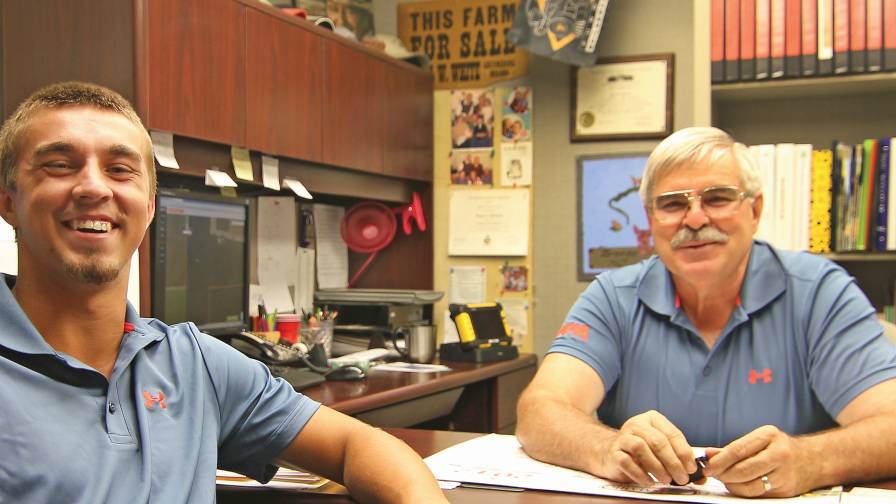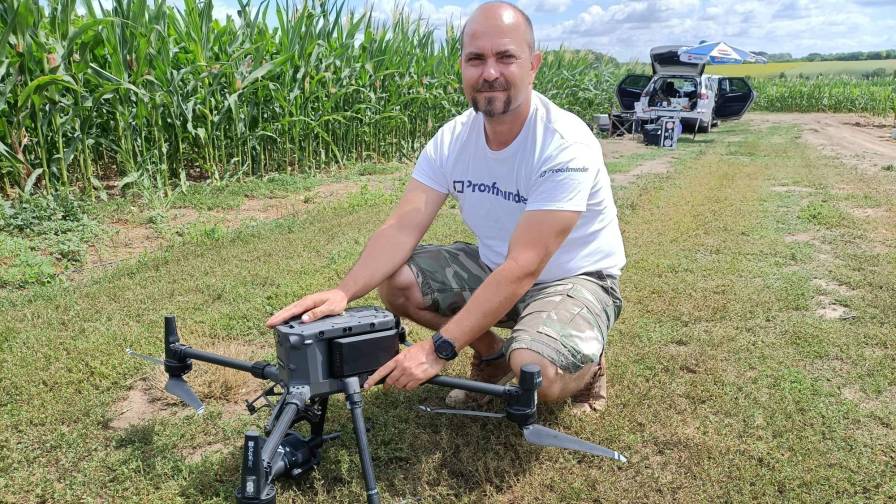There’s No Easy Button For Value in Variable-Rate Nutrition

At right, Roger DuMond of Kova Fertilizer shares experience, and a few laughs, with third-year intern Brandon Butz. “Sharing ideas with our younger employees is a joy, and we learn a lot this way,” says DuMond.
Roger Dumond has weathered the ups and downs of precision agriculture programs as much as anybody who’s been riding that train since practically the beginning. In 1995, his precision-centered career at Kova Fertilizer, an independent retail organization covering large swaths of southeast Indiana, began as many did in the “cradle of precision,” by marking boundaries and grid sampling for variable-rate fertility recommendations.
After working through three seasons of the grid sampling approach, Kova evolved rapidly into developing subzones from soil types, an approach that put the retailer in a clear minority back in 1998. In more recent years, the approach has matured to a process of analyzing various data layers that can affect crop growth and developing, and then fertilizing to match the needs of these zones. Kova sells its precision offerings under a brand called NextGPS Services.
Keeping the variable-rate rec program advancing and improving means that DuMond and his team needs to balance the hard-learned lessons of more than two decades of work with the possibilities and promise of emerging technologies and practices that might just work.
“We have seven millennials that have become a part of the organization over the last two years, and that tempers everything we say about emerging technology and new ways of working,” says DuMond. “I say things like, ‘well, this is the way I was taught,’ and we attempt to never say, ‘that’s just not going to work.’ I feel like I am innovative enough that I can buy into new ways of doing things.”
MORE BY PAUL SCHRIMPF
‘Future of Food’ Panel Will Deliver Compelling Close to 2022 VISION Conference in January
CoBank Report Asserts Precision Services are Essential to Future of U.S. Ag Retail
One fact he won’t budge on, though, is that there’s no magical help button black box that is going to replace the recommendations of a professional agronomist.
“The thing that bothers me about efforts like Farmers Business Network (FBN) is that there are a whole lot of people who take all the work we do for granted,” says DuMond. “We spend a lot of time second-guessing our own attempts at doing variable rate, and doing it properly, and it seems like it is all being minimized for a cheap price on fertilizer or a push-button solution. That irritates us to no end.”
DuMond, a self-proclaimed “data nut,” describes NextGPS’s approach with the mix of confidence and caution of someone who’s worked on variable-rate fertility programs for more than two decades. He’s enthusiastic about the value it can bring to a grower operation, especially as data is compiled and compared over the course of several years. But the struggle to ferret out the right variables, correctly read the data, and make a best possible recommendation is real. That doesn’t happen without a keen sense of customers’ desires, local conditions, and plain old solid agronomy.
That said, it’s worth it to establish a basis for decision-making and operational growth, and a key value point that leads to customer loyalty.
“Continuous improvement by the service provider is crucial to the future of all precision agriculture services that we — and other providers — offer to our customers,” says DuMond. “Dad’s and grandpa’s approaches to farming are rapidly being replaced by more innovative methods that are being brought to the farm by service providers and younger members of the farm family. Variable-rate fertilizer and other precision ag tools are now commonplace, but what we really need are more situations where the data and agronomy are being studied by the service provider and the grower, then fused into more sustainable approaches.
“A ‘quick button’ approach usually is plagued with fallacies,” he adds. “Providers need to be competent in utilizing imagery, soil testing, prescription fertility equations, yield data, and feet-on-the ground scouting.”
Heavy-Lifting
While many commonalities exist across Kova’s service territory (about 65% of its farmer customers are served via variable-rate prescription), every farm and farmer presents at least a somewhat unique fertility challenge. Building a solid VRA rec at NextGPS requires detailed understanding of farmer fields by soil type and yield and a strong understanding of the farmer’s goals for the season.
Its approach to soil sampling requires human interaction from the start, beginning with identifying zones of field production incorporating topographic and geological differences to ensure that soil sampling areas are matched up as closely as possible to zones of variability.
“Many times we subdivide the field before we interpolate data,” says DuMond. “If you are not really careful and you use surface interpolation techniques in a GIS platform, you could find yourself interpolating two sides of a stream with no validity whatsoever. So we will subdivide the field first, and then interpolate the results within the subzones.”
The process takes a lot of time, but DuMond asserts that “if you don’t interpolate properly, you’ll interpolate the truth right out of the room. We pinpoint sample point locations — I cannot stand a square sampling scheme — you can’t be more wrong than that in my opinion.”
Kova focuses on the traditional varied nutrients: lime, potassium, and phosphorus. DuMond does not count micronutrient application as variable despite its value, since most times it’s either “on” or “off” rather than applied at different rates. Varying nitrogen has proven too tricky to be relied on so far. “We’ve been writing nitrogen plans for six or seven years, and I don’t think I’ve written a good one yet,” says DuMond. “We’ve struggled to build a plan off of yield data.”
He has looked at Adapt-N types of modeling software for making Rx-based nitrogen recs and believes that if the system gets fed good data collected close to planting time with an in-season sidedress application, that Adapt-N is a viable option.
Software Shift: Positive Pain
Last October, Kova elected to change course on its corporate software program to EFC Systems, which included the FieldAlytics module for managing the precision division. DuMond describes the process of converting 20 years of data as “hellacious,” but nearly six months in, he and his team are reaping the benefits.
“We switched GIS software platforms, modified our internal procedures, and re-wrote many of our equations to try to match up with our growers’ needs for the future,” says DuMond. “We are gambling that the farmer of the future will realize our commitment, and value our particular approach to his fertility plans.”
He describes the software as “very efficient,” in particular with billing and moving and storing data through a cloud-hosted system. “We’re very comfortable we made the right choice,” says DuMond. It’s also leading Kova to phase out other software platforms to further streamline the system.
The system does afford grower-customers a peek at data via a dashboard, but DuMond says they have not pushed that aspect out very far. Loading down customers with excessive, out-of-context data actually leads more often to paralysis than action, he notes.
“I think we are working in a data overload industry,” says DuMond. “Some of the best decisions that get made are developed when we apply a full analysis and provide options A, B, or C for the farmer to choose from. When you open up the entire trough of information, more often than not nothing gets done.”
NextGPS additionally offers a glimpse of data through a dashboard generated by Mavrx. “We have two or three growers that have access, but they almost never use it,” says DuMond. That said, as younger generations return to the farm and interest in data grows, NextGPS will be ready to meet these demands.
VRA, Loyalty
Besides fostering continuous improvement and providing a regular avenue of discussion with farmer customers, a variable-rate nutrient regimen itself is a relationship-building experience that paves the way for improved customer loyalty.
“There are not many farmers who have not been exposed to it at this point, so when you’re working with them on variable rate prescriptions, it is business that is generally not up for bid every year,” says DuMond. “Data drives a lot of relationships with folks that we have worked with for many years. Usually, these customers’ acres stay with us year in and out. A lot of those doing conventional spreading are ‘shop-arounders,’ the kind that gravitate towards an FBN and the lowest price.”
The loyalty aspect became even more apparent through the recent downturn in the farm economy. “Farmers did not abandon variable-rate, they just flattened it down,” says DuMond. “As budgets shrunk in the past couple years, farmers have generally stayed convinced that VRA fertilizer applications were a correct decision, although most have reduced rates by using a ‘budget plan’ that does not aggressively build levels as much as we would if the farmer’s financial situation could stand it. Farmers seem to understand that fertility is a long term process, and a year or two on a reduced diet won’t drastically reduce their yields beyond a tolerable level.”
As a builder of business, customer loyalty, and ongoing value, DuMond feels VRA provides a terrific foundation for NextGPS’ sustainability as a business.
“We are convinced that an input supplier can, if properly motivated and compensated, provide impartial plans for our growers that are every bit as good as, or better than, ‘outside consultants’ that profess to be independent of a sales motive,” asserts DuMond. “In many cases, we feel that our advice is possibly even superior, since we probably know more about the farmer’s fields than anyone else, possibly even the farmer!”










